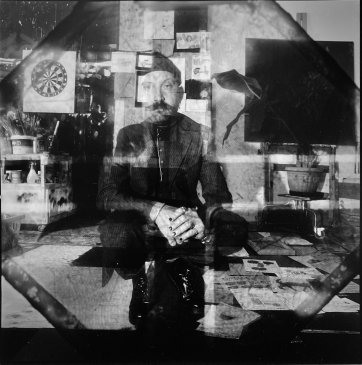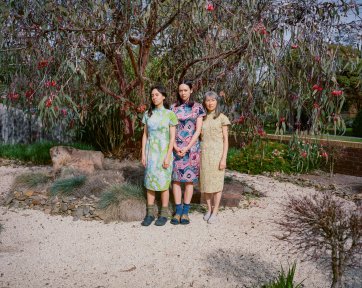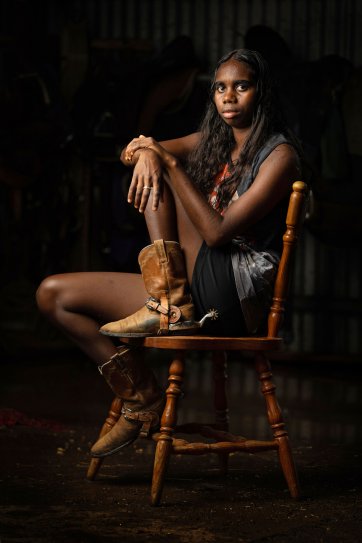The National Photographic Portrait Prize 2023 provides a rich, diverse and insightful glimpse of the past year through the lens of Australia’s professional and aspiring photographers. All art works were created between 1 December 2021 and 1 February 2023.
Celebrating its 16th year, the NPPP 2023 invites you on an amazing journey across Australia and beyond.
We encourage you to look, to feel, to think, to question and most importantly, to identify and connect.
The winner
The winning photograph, Shea Kirk’s portrait of Ruby, was chosen by three judges in a three-stage process. First, each judge looked at all of the entries online (there were about 2400!) and selected their long list. Second, the three judges met and looked at this long list of about 200 works on a large screen. They had access to the artists’ names, how the works were made, and the size of the works. From this, the judges selected 47 finalist works. Finally, the artists were invited to send their works to the Gallery, and the three judges looked at the framed photographs and chose the winner.
In making their decision, the judging panel – distinguished Australian photographer Tamara Dean; Director of the Australian Centre for Contemporary Photography Daniel Boetker-Smith; and the National Portrait Gallery’s Senior Curator Joanna Gilmour – said the work was a celebration of photography. ‘While Shea makes the portrait look effortless, this is a masterful and technically complex work where the sitter has no self-consciousness. It is as if the artist and sitter are participating equally in the transaction.’
What do you think of the winning work and why?
Process
Not all photographs are made the same way. Artists use different techniques to create a particular effect or achieve a level of clarity or texture.
Look at the labels and find three photographs that have been made using different processes. Look for similarities and differences between the images.
1 blood/memory: Brenda & Christopher I (Gurindji/Malngin/Mudburra; Mara/Ngarrindjeri/Ritharrngu; Anglo-Australian/Chinese/German/Irish/Scottish) 2021, 2022 Brenda L Croft, Prue Hazelgrove (Photographic Assistant). 2 Portrait of My Mother As An Ethno-Futurist Icon, 2023 Sammaneh Pourshafighi. 3 'Sunju Calabrese' #2, 2022 Renato Colangelo.
Who are you hanging with?
A lot of time goes into designing the placement of the photographs in the NPPP exhibition. Some photographs have been placed together because they tell a similar story, sometimes it’s about the process, sometimes it’s about the mood conveyed.
Looking closely, choose two photographs you like and think about what connects them.
Identify why you like them side by side – are they similar in colour, story or the process?
1 Strong Avenue, Graceville, Brisbane, 2022 Stuart Miller. 2 Yarnangu, 2023 David Darcy.
Tasks for students or family groups
- Find the portrait Mum helping with canvas by Sarah Enticknap. Photographs of friends and family help us to remember special moments. Think of a memory captured in a photograph. Write a short story about your memory.
- Find the portrait Self portrait with my mother and sister by Anne Moffatt. A tree was planted as a seedling in the artist’s backyard and grew up alongside her. Do you have a pet or tree or sibling that is growing up with you? Design some photographs of you together.
- Some NPPP photographs were not taken in Australia. Let’s travel across to Ethiopia in Africa to meet Abraham Admasu, a year 11 student. Take a moment to look at Abraham’s stance, what does this convey? How would you pose in a portrait? What would you like people to see when looking at your portrait? Experiment with different poses and consider what they communicate.
1 Mum helping with canvas, 2022 Sarah Enticknap. 2 Self portrait with my mother and sister, 2022 Anne Moffat. 3 Abraham Admasu (School of St Yared student, Addis Ababa, Ethiopia), 2022 Dylan Le’Mon.
Drawing activities – pencil and paper
- More than one! Let’s look at Marawa the Amazing by Jo Duck. Sometimes stories are better told with more than one photograph – in photography, we call this a photo essay.
- Take a pencil and lots of small pieces of paper. Think of a simple subject like a ball bouncing and draw the object on each piece of paper, each time changing its position slightly. Then staple it together to create a little animation flipbook.
- Look closely at the diversity of portraits in the NPPP, what makes them unique? Think about what makes you, you and draw a self portrait.
- There are lots of black and white artworks in the NPPP. Do you think some images are stronger than others? Consider the artists’ choice of black and white or colour. Draw two images the same, add colour to one and leave the other black and white, then compare and contrast.
For older students and groups
There are many different themes and approaches in NPPP 2023.
- In creating Serenity, Forough Yavari was influenced by a poem by Langston Hughes. Think about what influences you and talk to your group to see if you have similar or different thoughts.
- Téa-Anna Parvathy Murrin questions cultural identity in Australia, asking ‘what does it mean to be an Australian?’ Discuss in a group how Australian identity is evolving and what roles we might play.
- Jimmy Widders Hunt’s Our First Lesson encourages us all to learn from our First Nations Elders. Traditionally possum skin cloaks were given at birth and added to as the owner grew. In this photograph, we can see Peter Peckham’s possum skin cloak is of great importance to him. How has the artist captured this?
- Read the label on Nathan Dyer’s Anne and compare this photograph to Our First Lesson by Jimmy Widders Hunt. Discuss the similarities and differences. Consider the cultural influences and the impact they have on you.
- Choose a photograph and write your own statement without reading the label. Compare your statement with the artist’s and discuss.
1 Serenity, 2021 Forough Yavari. 2 Téa-Anna Parvathy Murrin – Australian cultural identity, 2023 Franca Turrin. 3 Our First Lesson, 2022 Jimmy Widders Hunt. 4 Anne, 2022 Nathan Dyer.




























